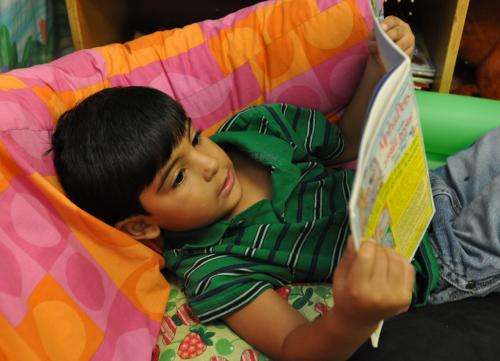Credit: Frank Porter Graham Child Development Institute
A comprehensive review of research on young Latino and Spanish-speaking children confirms that widely available public programs are helping dual-language learners make important academic gains. According to scientists at UNC's Frank Porter Graham Child Development Institute (FPG), children who have lower English-language abilities than their peers benefit the most from programs like Head Start and public pre-k—but exactly how and why remain unanswered questions.
"We know that early childhood is a critical period for children who are dual-language learners," said Virginia Buysse, senior scientist at FPG and lead author of the review. "Many of them face the difficult task of learning a new language while acquiring essential skills to be ready for kindergarten."
Buysse said that dual-language learners represent a large and rapidly growing group of children in the U.S. In 2006, nearly one in three children enrolled in Head Start or Early Head Start lived in a household in which a language other than English was spoken.
According to co-author and fellow FPG senior scientist Ellen Peisner-Feinberg, dual-language learners enter kindergarten with skills that differ substantially from their peers. "English proficiency has been linked to school performance, educational attainment, and the future economic mobility of Latino students," said Peisner-Feinberg. "These children lag behind their peers when they begin school, though, and the gap only widens as they grow older."
Buysse and Peisner-Feinberg emphasized that improving language skills in turn provides a foundation for learning in other content areas. "But relatively few studies have evaluated the effects of early care and education programs for dual-language learners," said Buysse.
In 2007, the National Task Force on Early Childhood Education for Hispanics had referred to this knowledge gap as one of the most important unanswered questions within the field of early childhood education. Buysse and Peisner-Feinberg wanted to gauge the current state of research and conducted a comprehensive review of the latest studies, screening 4000 initial candidates from several academic databases before determining 25 that met their rigorous selection criteria.
Buysse said the dearth of top-caliber research itself was an important finding. "This is a surprisingly small group of studies, given the number of children under the age of five in this country who do not speak English as their home language."
Almost all of the studies focused on Latino or Spanish-speaking children who were 3–5 years old. Most were in enrolled in center-based early childhood programs.
On the basis of these scientifically sound studies, Buysse and Peisner-Feinberg did find evidence to suggest that dual-language learners benefit from attending widely available, well regulated early child-hood programs, such as Head Start or state-funded public pre-k. Moreover, these programs may be more beneficial for children who begin school with lower English-language abilities and less exposure to English—findings consistent with previous research.
"We also found some support across several studies both for using English as the language of instruction and for incorporating the home language into strategies that focused on language and literacy," said Buysse. "And none of the studies detected any negative effects of early education programs and instructional practices that target dual-language learners."
Buysse added, though, that small sample sizes and other methodological challenges necessitated more research in order to demonstrate exactly which interventions truly hold the most promise for dual-language learners.
With co-authors Mariela Páez of Boston College, Carol Hammer of Temple University, and FPG's Meagan Knowles, Buysse and Peisner-Feinberg published the results of their review in an advance online article for Early Childhood Research Quarterly.
More information: Buysse, V., et al. Effects of early education programs and practices on the development and learning of dual language learners: A review of the literature. Early Childhood Research Quarterly (2013), dx.doi.org/10.1016/j.ecresq.2013.08.004
Provided by Frank Porter Graham Child Development Institute



















